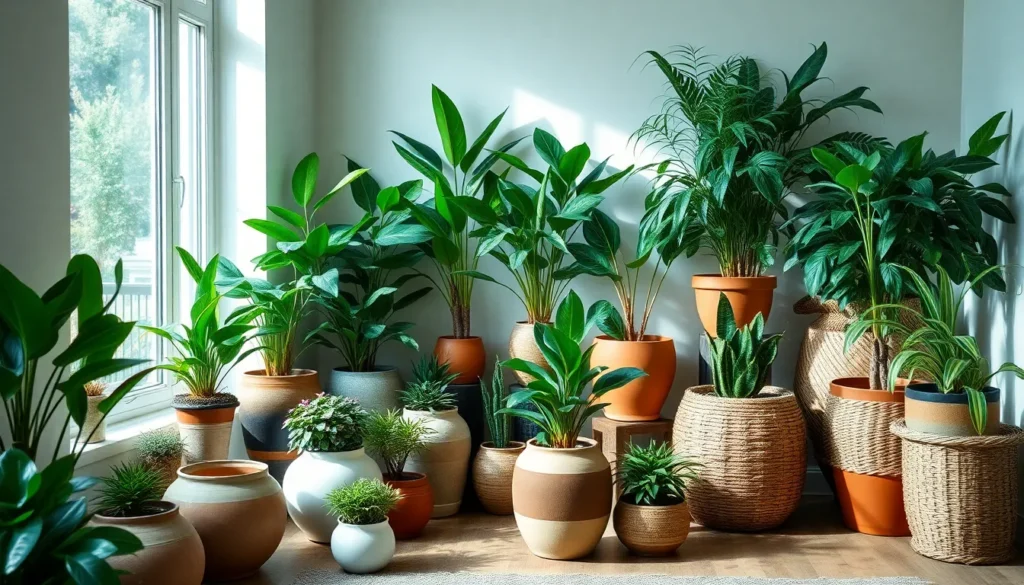Transforming our living spaces with indoor plants has become more popular than ever but choosing the right pots can make or break our green sanctuary. We’ve all stood in the garden center overwhelmed by countless pot options wondering which ones will complement our home’s style while keeping our plants thriving.
The perfect plant pot does double duty – it’s both a functional home for our leafy friends and a design element that elevates our interior décor. From sleek modern ceramics to rustic terracotta classics we’ll explore creative pot ideas that suit every budget and aesthetic preference.
Whether we’re dealing with tiny succulents on windowsills or statement floor plants in living rooms the right container choice can transform ordinary greenery into stunning focal points. Let’s jump into innovative pot ideas that’ll help us create the indoor oasis we’ve been dreaming of.
Creative DIY Plant Pot Ideas for Your Indoor Garden
Transforming ordinary materials into stunning plant containers lets us express our creativity while staying within budget. We’ll explore innovative approaches that turn everyday items into personalized planters for our indoor spaces.
Upcycled Household Items as Planters
Tin cans become charming rustic planters when we remove labels and add drainage holes. We can wrap them with twine, paint them in coordinating colors, or leave the metal exposed for an industrial look. Mason jars work perfectly for herbs and small succulents, especially when we add handles using wire or leather straps.
Old boots and shoes create whimsical containers that add personality to our plant displays. We drill drainage holes in the soles and line them with plastic to protect the material. Rain boots, canvas sneakers, and leather work boots all make excellent conversation pieces.
Plastic bottles transform into self-watering planters with minimal effort. We cut the bottle in half, invert the top portion into the bottom, and thread string through the cap to create a wick system. This method works exceptionally well for growing herbs on windowsills.
Wooden crates and boxes provide ample space for larger plants or multiple smaller ones. We line them with plastic sheeting and add a layer of gravel for drainage. Wine crates, old drawers, and shipping boxes all serve as excellent foundation materials.
Hand-Painted Terra Cotta Transformations
Geometric patterns elevate basic terra cotta pots into modern art pieces. We use painter’s tape to create clean lines and fill sections with contrasting colors like navy blue, sage green, or dusty rose. Triangle patterns, chevron designs, and color blocking techniques work particularly well.
Metallic accents add sophistication to our plant containers. We apply copper, gold, or silver leaf paint to create elegant finishes that complement both modern and traditional décor. Brushing metallic paint onto raised textures or rim edges creates subtle luxury touches.
Nature-inspired motifs bring organic beauty to our planters. We paint botanical illustrations, leaf patterns, or abstract landscapes using acrylic paints. Watercolor techniques create soft, flowing designs that pair beautifully with flowering plants and trailing vines.
Textured surfaces add dimension to our painted pots. We apply modeling paste or thick acrylic medium before painting to create raised patterns. Stippling with sponges, creating crosshatch patterns, or using stencils adds visual interest and tactile appeal.
Macrame Hanging Pot Covers
Basic macrame holders require only cotton cord and simple knots to create functional plant hangers. We start with four equal lengths of cord, tie them together at the top, and create a cradle pattern using square knots and gathering techniques. These holders accommodate various pot sizes and add bohemian charm to our spaces.
Layered fringe designs incorporate multiple tiers of decorative elements. We add beads, shells, or wooden rings between knot sections to create movement and visual interest. Varying the fringe lengths creates cascading effects that complement trailing plants like pothos or spider plants.
Colorful cord combinations let us match our plant hangers to existing décor. We combine natural jute with dyed cotton cord in jewel tones, pastels, or neutral shades. Ombre effects, where colors gradually transition from light to dark, create particularly striking displays.
Wall-mounted versions save floor space while creating vertical garden displays. We anchor these holders to wall hooks or ceiling brackets and adjust the hanging lengths to create layered arrangements. Multiple holders at varying heights transform blank walls into living art installations.
Modern Minimalist Indoor Plant Pot Styles
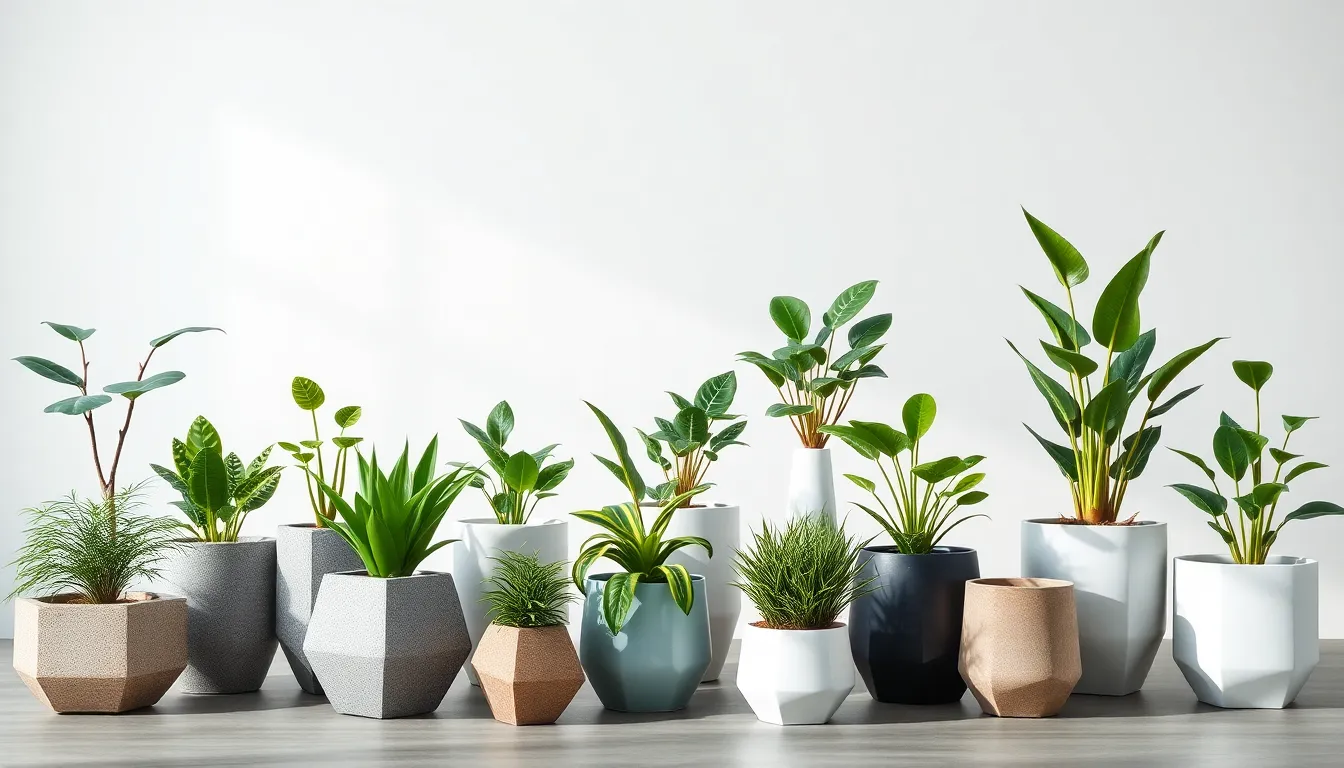
After exploring creative DIY options, we’re shifting focus to sleek contemporary designs that embody the minimalist philosophy of “less is more.”
Sleek Concrete Planters
Concrete planters deliver the perfect industrial edge that modern minimalist spaces crave. Their smooth surfaces and neutral gray tones create a sophisticated backdrop that lets your plants take center stage without competing for attention. We love how these durable containers provide sturdy foundations for everything from small succulents to medium-sized houseplants.
The beauty of concrete lies in its versatility – it complements natural materials while maintaining that clean, uncluttered aesthetic that defines minimalist design. These planters work exceptionally well in spaces that emphasize organic textures and raw materials, bringing an architectural quality to your indoor garden.
Geometric Metal Containers
Metal planters with sharp geometric lines introduce contemporary sophistication to any minimalist space. We particularly appreciate how black metal containers create striking contrast against green foliage, while brass options add subtle warmth without overwhelming the clean design principles.
These structured shapes serve as sculptural elements themselves, making them ideal companions for plants with strong architectural forms like snake plants or fiddle leaf figs. The angular designs create visual focal points that maintain minimalist restraint while adding just enough interest to elevate your plant display.
Clean-Lined Ceramic Options
Ceramic pots with smooth finishes and crisp edges represent the quintessential minimalist planter choice. White and neutral-colored ceramics provide that perfect backdrop that emphasizes your plant’s natural form and vibrant foliage. We find these containers integrate seamlessly into modern decor schemes that prioritize simplicity and order.
Both matte and glossy finishes offer textural variety while maintaining that pared-down aesthetic minimalist interiors demand. These versatile pots work beautifully as dining table centerpieces, workspace accents, or bathroom greenery additions without creating visual clutter in your carefully curated space.
Rustic and Natural Indoor Plant Pot Concepts
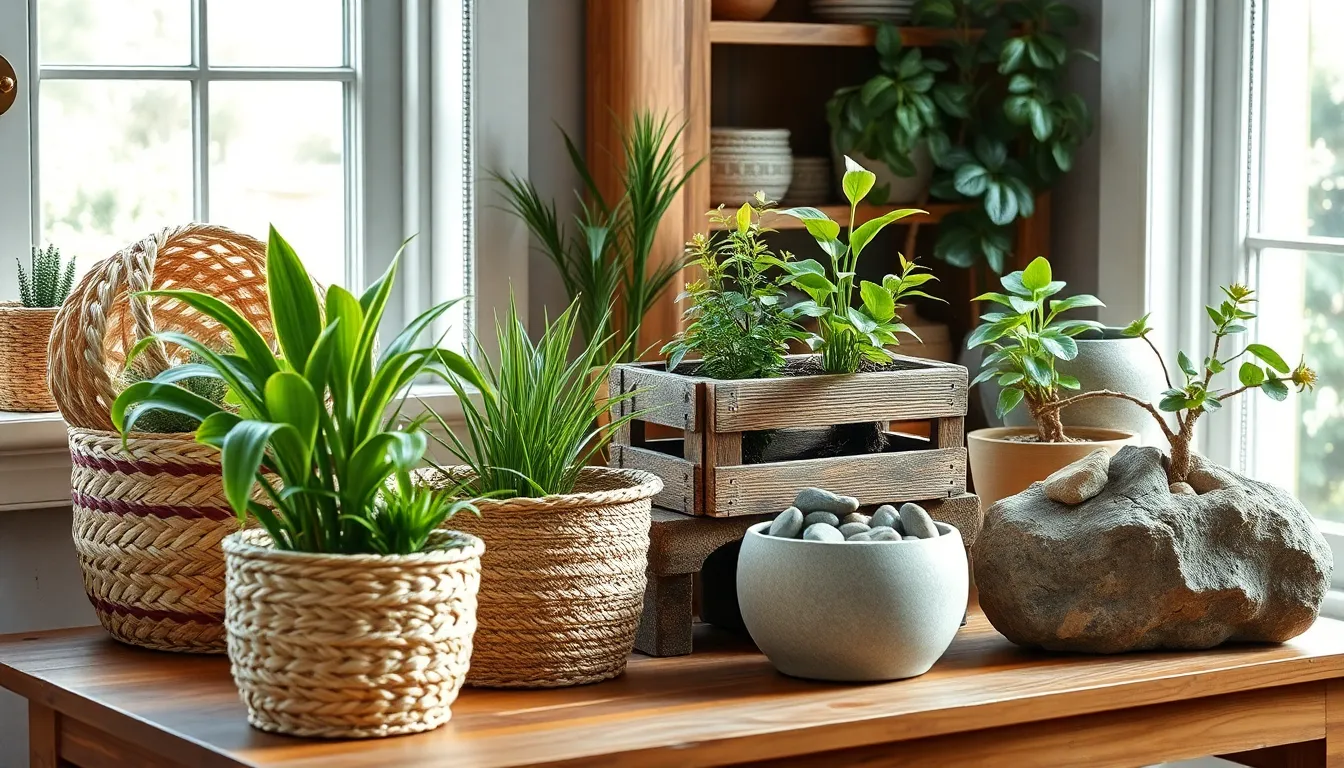
Natural materials and earthy textures create warm, inviting spaces that celebrate organic beauty. These rustic options bring authentic charm while providing functional homes for your favorite plants.
Woven Basket Planters
Woven basket planters offer natural fiber construction that adds instant texture and warmth to any room. Rattan, seagrass, and wicker materials create breathable containers that complement farmhouse, bohemian, and coastal decor styles perfectly. These lightweight options work exceptionally well for plants requiring good air circulation around their root systems.
Texture becomes the star when you choose woven materials for your indoor garden. Natural fibers provide visual interest while maintaining a relaxed, organic feel throughout your space. Durability varies by material, with rattan offering excellent longevity for long term use.
Wooden Crate Containers
Wooden crate containers showcase natural wood grain that brings rustic authenticity to contemporary spaces. Paulownia wood planters feature smooth finishes and natural grain patterns that fit seamlessly into Scandinavian, farmhouse, and rustic interior designs. Raw or lightly finished wood creates vintage appeal when you repurpose actual shipping crates as unique planters.
Construction typically lacks drainage holes, making these containers ideal for plants needing minimal water or artificial greenery displays. Custom crafted wooden boxes provide modern interpretations of this classic rustic style. Maintenance involves occasional wood conditioning to preserve the natural beauty and prevent cracking.
Stone and River Rock Designs
Stone planters deliver unmatched durability while creating grounded, earthy aesthetics in your indoor spaces. Real stone materials offer authentic texture and weight that anchors plant displays with natural elegance. Faux stone alternatives provide similar visual appeal with reduced weight for easier positioning.
River rock designs incorporate smooth, polished stones arranged artistically to create unique decorative covers or standalone pots. These materials blend seamlessly with greenery while adding sculptural elements to your plant collection. Textured surfaces on stone containers enhance the natural, organic feel that defines rustic decor aesthetics.
Space-Saving Vertical Indoor Plant Pot Solutions

Vertical gardening transforms limited indoor spaces into thriving green sanctuaries, making it perfect for apartments and small homes. We’ll explore innovative ways to maximize your growing potential without sacrificing precious floor space.
Wall-Mounted Planter Systems
Wall-mounted planters turn ordinary walls into living artwork using modular planter units, hanging baskets, and creative DIY answers. These systems work exceptionally well for herbs like basil, cilantro, and parsley, while compact vegetables such as radishes, baby carrots, and cherry tomatoes thrive in vertical arrangements.
Fabric pocket gardens offer a popular space-saving option that holds soil and plants securely against walls or balconies. Repurposed materials like old pallets and rain gutters create budget-friendly vertical gardens that serve both functional and decorative purposes. Trailing flowers including petunias, nasturtiums, and bacopa add cascading beauty to these vertical displays.
Growing salad greens like lettuce, arugula, and spinach becomes effortless with wall-mounted systems that provide easy access for harvesting. Plants receive adequate light exposure while maximizing limited floor space in urban environments.
Tiered Plant Stands
Tiered plant stands create structured vertical layers that display multiple plants within a compact footprint. Available in 3-tier and 5-tier configurations, these stacking systems accommodate various plant sizes from small herbs to medium-sized decorative plants.
Multi-level designs maximize vertical space while maintaining easy access to each plant for watering and maintenance. Materials range from lightweight plastic to sturdy wood and metal, offering options for different weight requirements and aesthetic preferences.
Versatility makes tiered stands ideal for both indoor and outdoor arrangements, supporting everything from succulent collections to flowering plants. These structured systems provide stability and organization while creating visually appealing displays that draw the eye upward.
Hanging Garden Arrangements
Hanging gardens use suspended pots and baskets that free up floor and shelf space while adding greenery at varying heights. These arrangements work perfectly for trailing plants like pothos, spider plants, and string of pearls that naturally cascade downward.
Cherry tomatoes and compact herbs thrive in hanging baskets, making productive use of overhead space in kitchens and sunny windows. Mixed arrangements combining trailing flowers with upright compact species create ever-changing visual interest while maximizing growing potential.
Suspended planters add depth and dimension to rooms by utilizing the often-overlooked ceiling space. Trellis systems can be incorporated into hanging arrangements to support climbing vegetables like cucumbers, pole beans, and peas, effectively combining vertical growth with decorative appeal.
Decorative Themed Indoor Plant Pot Ideas
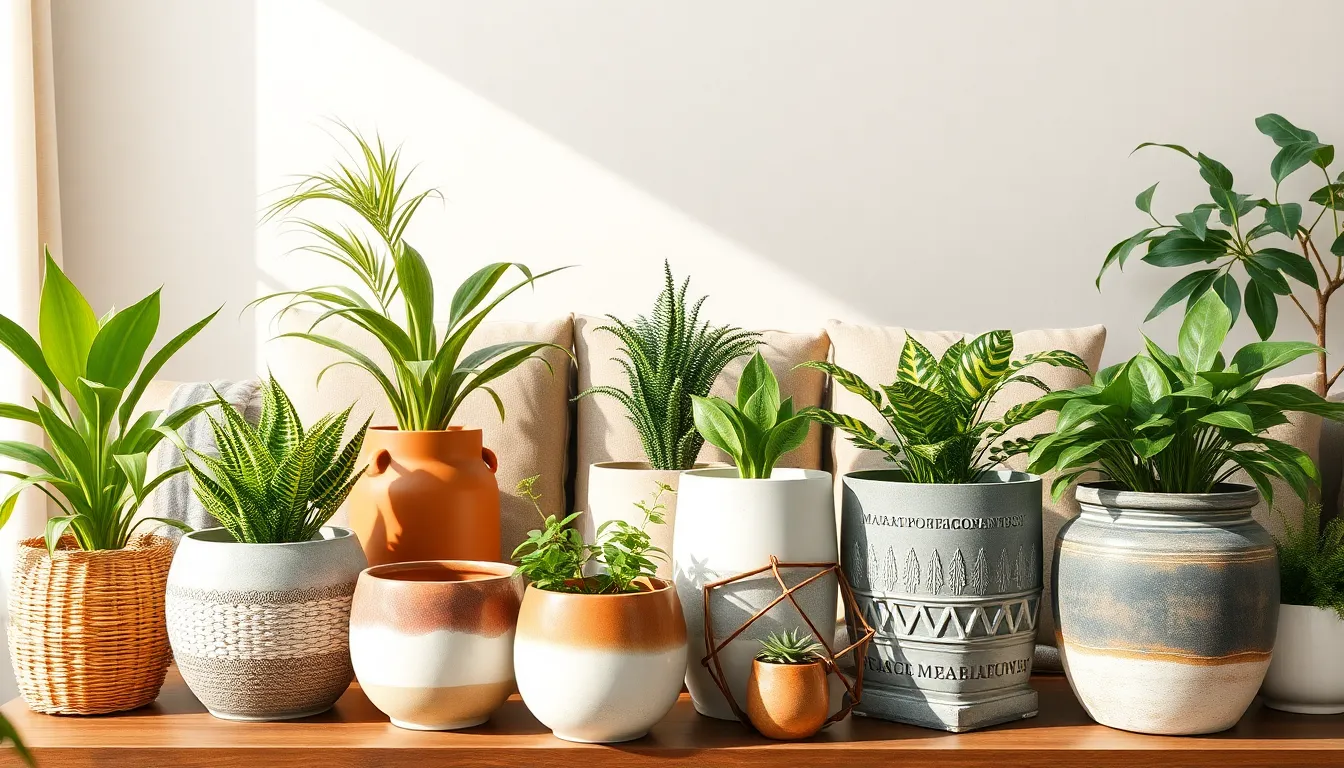
Themed plant pots let us express our personal style while creating cohesive design narratives throughout our living spaces. We’ll explore three distinct decorative approaches that transform ordinary containers into stunning focal points.
Bohemian Style Planters
Bohemian planters embrace handwoven materials like bamboo and pine wood that create texture and visual interest in our indoor gardens. Natural materials form the foundation of boho design, with decorative woven patterns and tripod stands that lift plants off the floor for layered dimension. Eco friendly bamboo planters featuring airy baskets and natural wood stands combine durability with a playful, eclectic vibe that works beautifully in sets of varying heights.
Materials range from bamboo and ceramic to plastic and fabric, with many boho pots including practical features like drainage holes or self watering systems. Earthy tones dominate the color palette, emphasizing an artistic and relaxed atmosphere that suits both indoor and outdoor environments. Colorful hand painted designs add whimsical touches to our plant displays, with rainbow patterns and mushroom motifs creating unique conversation pieces.
Texture plays a crucial role in bohemian styling, where woven designs and natural finishes create an organic feel that complements our plants’ natural beauty. Height variation becomes essential when arranging multiple boho planters, allowing us to build visual interest through dimensional layering. Natural wood stands provide both elevation and authentic charm that enhances the overall bohemian aesthetic.
Industrial Chic Containers
Industrial containers emphasize raw materials like metal and concrete that create minimalist shapes with rugged, utilitarian appeal. Metal pots showcase the authentic industrial look we’re seeking, while concrete planters offer simple geometric forms that pair beautifully with lush green foliage. Urban loft aesthetics emerge when we combine these materials with functional design elements.
Concrete planters bring an edgy sophistication to our indoor spaces, with their substantial weight and neutral tones providing the perfect backdrop for vibrant plants. Metal containers introduce sleek lines and contemporary appeal, often featuring weathered or brushed finishes that add character without overwhelming our plants. Wood and metal combinations create striking contrasts that embody the industrial chic philosophy.
Utilitarian design principles guide our container selection, where function meets form in perfectly balanced proportions. Raw finishes celebrate the authentic beauty of materials like steel, iron, and poured concrete. Geometric shapes maintain clean lines while adding architectural interest to our plant arrangements.
Vintage Inspired Pot Designs
Vintage ceramic pots feature classic shapes and aged finishes that transport us back to earlier decades through timeless design elements. Crackled glazes and hand painted patterns create authentic vintage appeal, with floral, dotted, and geometric motifs rendered in muted or pastel color schemes. Weather resistant ceramics ensure these beautiful containers maintain their charm while providing practical indoor plant housing.
Natural wood stands complement vintage ceramic designs, blending antique charm with modern functionality for versatile plant displays. Classic shapes evoke nostalgia while serving contemporary needs, creating cozy plant arrangements that feel both familiar and fresh. Aged finishes add character and depth, making each pot feel like a treasured find from bygone eras.
Hand painted details distinguish quality vintage inspired planters, with artisanal touches that celebrate traditional craftsmanship. Ceramic materials provide excellent growing conditions for our plants while showcasing beautiful glazes and textures. Timeless appeal ensures these vintage designs remain stylish regardless of changing decorating trends.
Budget-Friendly Indoor Plant Pot Alternatives
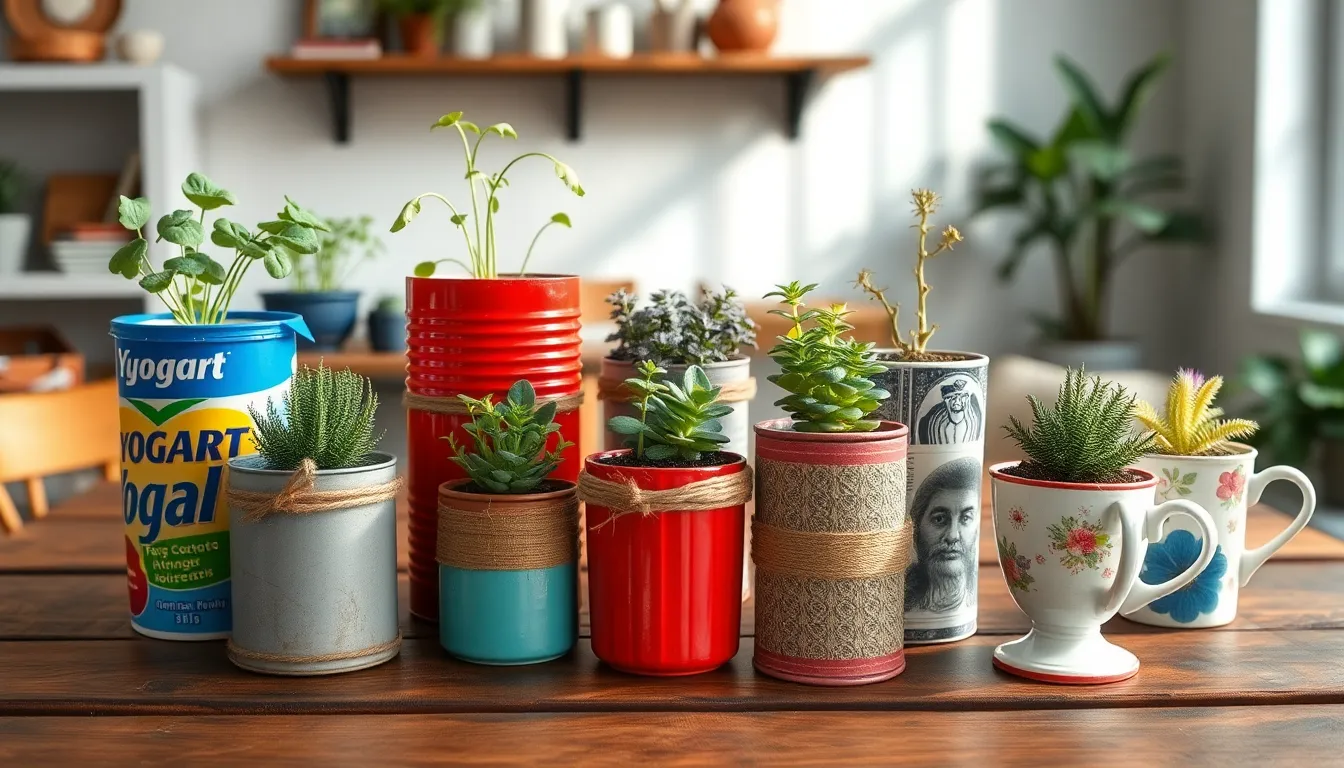
Creating beautiful indoor gardens doesn’t require expensive containers when you know where to look for affordable alternatives. We’ll explore three clever approaches that transform everyday items into stunning planters without breaking your budget.
Repurposed Food Containers
Empty food containers offer endless possibilities for creative plant displays at zero cost. Old Bay cans work perfectly for small herbs and succulents, while plastic serving bowls accommodate larger plants with proper drainage holes added. We can transform these containers using simple techniques like spray painting for a concrete-like finish or creating silhouette designs with stencils.
Yogurt containers, coffee cans, and large food jars become charming planters when decorated with rope wrapping, fabric covers, or chalkboard paint for labeling. These repurposed containers perform especially well for starting seedlings or housing compact plants like pothos and snake plants. The key lies in drilling adequate drainage holes and adding a decorative touch that matches your interior style.
Dollar Store Planter Makeovers
Dollar Tree and similar stores stock basic plastic pots that transform into designer-looking planters with minimal investment. We can create 20-30 attractive containers using supplies like spray paint, painter’s tape, and paint pens without exceeding a modest budget. Modern geometric patterns emerge when we use tape to create clean lines before applying metallic or matte finishes.
Paint pens allow us to add sophisticated details like dots, stripes, or botanical motifs to plain containers. Textured spray paints create stone-like or hammered metal effects that rival expensive store-bought options. IKEA’s affordable plastic pots also serve as excellent blank canvases for these transformation techniques, offering slightly better quality at minimal extra cost.
Free and Found Material Options
Thrift stores and garage sales provide treasure troves of unique planters that need no additional decoration. Vintage teacups work beautifully for air plants and small succulents, while old colanders create excellent hanging planters with built-in drainage. IKEA trash cans become striking floor planters once we drill drainage holes and add a plastic liner.
Found materials from nature offer organic planting answers that complement rustic decor styles. Large shells, hollowed gourds, and interesting stones create one-of-a-kind containers for air plants and small specimens. We recommend using these decorative containers with plastic liners placed on rocks or marbles to ensure proper drainage while protecting both the plant and the unique vessel.
Old rain boots, worn-out handbags, and vintage seed packets mounted in shadow boxes provide whimsical alternatives that spark conversation. These found treasures often possess character and history that mass-produced pots simply cannot match.
Specialized Indoor Plant Pot Ideas by Plant Type
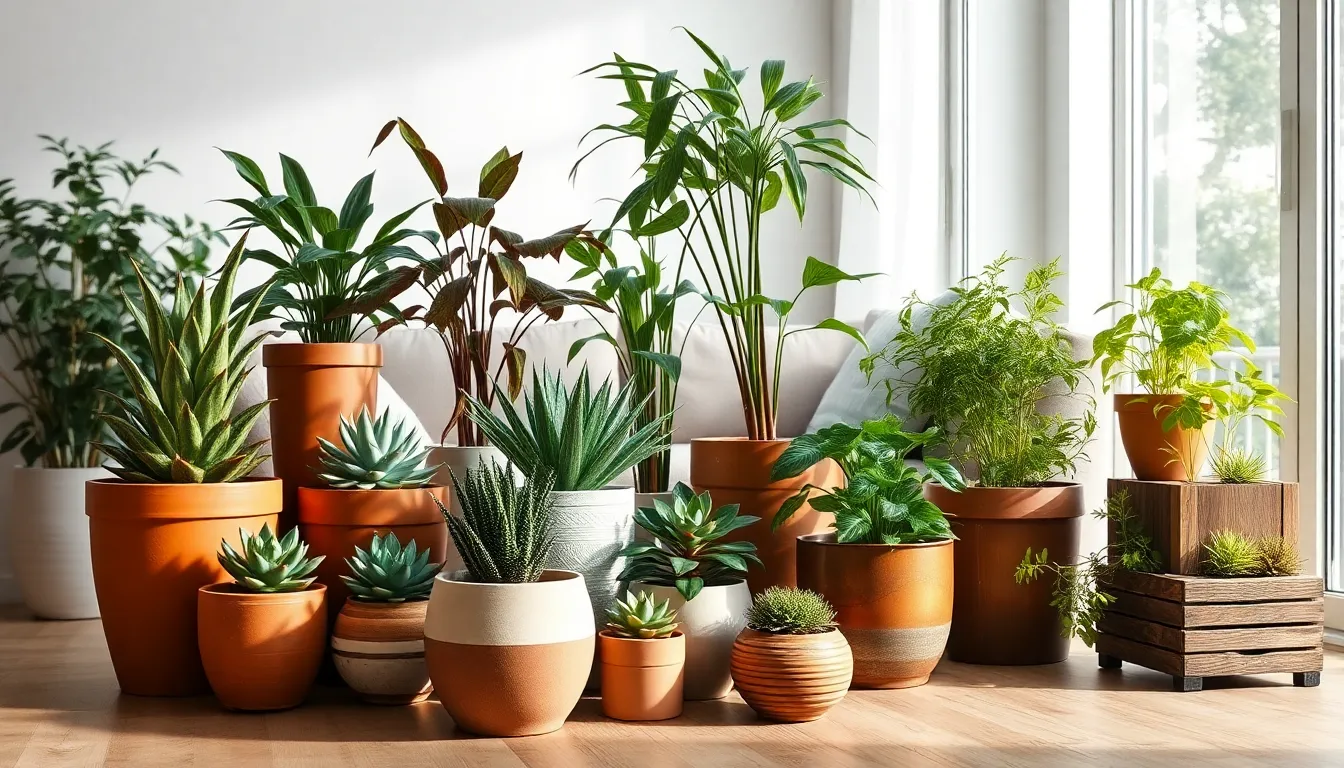
Different plants have unique needs that require exact container considerations. We’ll explore customized pot answers that ensure your plants thrive while complementing your indoor décor.
Succulent-Exact Container Designs
Shallow wide mouth planters work best for succulents since these plants spread horizontally rather than growing deep roots. Ceramic, terracotta, and wooden materials provide the essential drainage that prevents root rot in moisture sensitive plants.
Terrariums and open top glass containers showcase succulents beautifully while preventing overwatering issues. Glass vessels allow you to monitor soil moisture levels and create stunning displays with colorful stones or decorative sand layers.
Materials matter significantly when choosing succulent containers since poor drainage kills these desert plants quickly. Terracotta naturally wicks moisture away from roots, while ceramic offers decorative options with proper drainage holes.
Large Floor Plant Pot Answers
Heavy duty materials like fiberglass and ceramic prevent large plants from tipping over when they reach mature sizes. Lightweight plastic containers often can’t support tall plants like fiddle leaf figs or rubber trees effectively.
Rectangular and square planters offer superior stability compared to round pots for floor plants. The Jay Scotts Torino Rectangular Planter provides excellent stability and creates clean arrangement lines in modern spaces.
Size considerations become critical when selecting floor plant containers since undersized pots restrict root growth and cause instability. Large plants need containers that are at least one third the height of the plant for proper proportions.
Small Herb Garden Containers
Wooden and ceramic planters suit herb gardens perfectly due to their natural appearance and easy maintenance requirements. Cedar and treated wood resist moisture damage while ceramic options offer endless color possibilities.
Compartmentalized shallow planters allow organized growth of different herbs without root competition. Square designs like the Kathryn Square Tapered Planter maximize growing space while facilitating efficient watering routines.
Small container gardens work exceptionally well for herbs since most varieties prefer contained root systems. Separate pots prevent aggressive spreaders like mint from overtaking slower growing herbs like oregano and thyme.
Seasonal Indoor Plant Pot Decoration Ideas
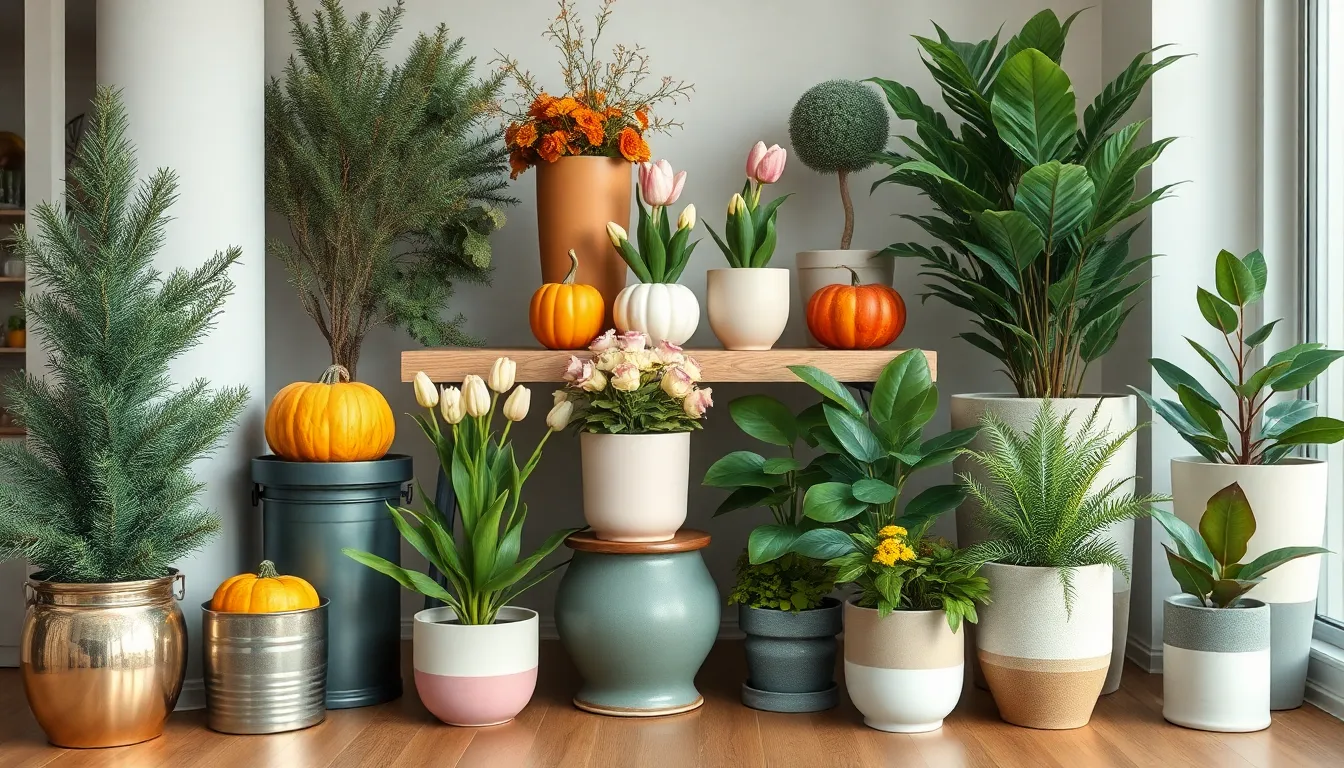
Seasonal plant pot decoration allows us to refresh our indoor spaces throughout the year while celebrating each season’s unique beauty. We can transform our indoor gardens by switching out planters and plants to match the changing seasons and holidays.
Holiday-Themed Planter Designs
Christmas planters create magical indoor displays when we use containers with metallic finishes or rustic textures. We fill these festive planters with evergreen branches, holly, or small pine trees to capture the holiday spirit. Adding string lights, ornaments, or garlands transforms these arrangements into stunning centerpieces that illuminate our living spaces.
Thanksgiving celebrations benefit from warm toned pots paired with seasonal plants like mums, ornamental kale, or pansies. We enhance these autumn displays by placing decorative pumpkins and gourds around the planter bases. These natural elements create cozy harvest themed arrangements that welcome guests into our homes.
Easter brings opportunities for pastel colored planters filled with spring flowers like tulips and daffodils. We incorporate easter themed decorations such as ceramic eggs, miniature bunnies, or ribbon accents to create cheerful seasonal displays. These soft color palettes brighten our indoor spaces after the long winter months.
Summer Bright Color Schemes
Vibrant summer planters energize our indoor spaces with bold colors that reflect the season’s warmth and vitality. We achieve striking summer displays using bright plant pots in red, orange, and yellow paired with tropical plants like hibiscus or bird of paradise. These eye catching combinations bring the outdoor sunshine indoors.
Playful arrangements featuring succulents and primrose add lively touches to our summer décor. We create ever-changing groupings by mixing different pot sizes and heights while maintaining the bright color theme. These low maintenance plants thrive in our indoor environments while providing continuous visual interest.
Tropical inspired container gardens transport us to exotic destinations when we combine colorful ceramic planters with bold foliage plants. We select plants with dramatic leaves and vibrant flowers to complement our bright summer color schemes. These arrangements serve as focal points that energize any room.
Winter Neutral Tones
Winter planter designs embrace sophisticated neutral palettes that create calm, serene indoor environments. We choose planters in beige, gray, or white to establish a foundation for elegant winter displays. These neutral tones provide perfect backdrops for seasonal greenery and decorative elements.
Metallic finished planters add glamour to our winter arrangements without overwhelming the space. We incorporate silver, gold, or bronze containers that reflect light and create visual warmth during darker months. These sophisticated finishes elevate simple evergreen arrangements into elegant seasonal displays.
Rustic textured planters bring natural beauty to our winter décor through organic materials and earthy finishes. We pair these containers with evergreen branches, winter berries, or small coniferous plants. Adding subtle lighting or natural ornaments completes these understated yet beautiful winter arrangements.
Conclusion
We’ve explored countless ways to transform your indoor space with creative plant pot ideas that suit every style and budget. From sleek minimalist designs to rustic natural materials and space-saving vertical answers your options are truly endless.
The beauty of indoor plant styling lies in finding containers that reflect your personality while supporting your plants’ health. Whether you’re repurposing everyday items crafting DIY masterpieces or investing in specialized planters the right pot becomes both functional necessity and decorative statement.
Remember that seasonal updates and themed approaches keep your indoor garden fresh and captivating throughout the year. With these diverse pot ideas you’re equipped to create an indoor oasis that grows and evolves with your changing tastes and living space needs.
Frequently Asked Questions
What are the best materials for indoor plant pots?
The best materials for indoor plant pots include ceramic, terracotta, concrete, wood, and metal. Ceramic offers versatility and style, terracotta provides excellent drainage, concrete gives an industrial look, wood adds natural warmth, and metal containers offer modern sophistication. Choose based on your décor style, plant needs, and budget.
How can I make DIY plant pots on a budget?
You can create budget-friendly DIY plant pots by upcycling household items like tin cans, mason jars, old boots, and plastic bottles. Transform terra cotta pots with hand-painted designs, geometric patterns, or metallic accents. Repurpose food containers and upgrade dollar store pots with spray paint and decorative patterns.
What pot styles work best for minimalist décor?
For minimalist décor, choose clean-lined ceramic pots, concrete planters with industrial edges, and geometric metal containers. These styles embody the “less is more” philosophy, featuring simple designs without visual clutter. Neutral colors and sleek shapes allow plants to take center stage while maintaining sophistication.
How do I choose the right pot size for different plants?
Succulents need shallow, wide-mouth planters for proper drainage. Large floor plants require heavy-duty pots made from fiberglass or ceramic to prevent tipping. Small herbs work well in compartmentalized wooden or ceramic containers. Always ensure pots have adequate drainage holes and room for root growth.
What are some space-saving plant pot solutions for small homes?
Maximize limited space with wall-mounted planter systems, tiered plant stands, hanging garden arrangements, and vertical fabric pocket gardens. Repurpose old pallets for budget-friendly vertical gardens. These solutions transform walls into living artwork while freeing up valuable floor space in apartments and small homes.
How can I decorate plant pots for different seasons?
Create seasonal displays by using holiday-themed planters with evergreen branches for Christmas, warm-toned pots for Thanksgiving, and pastel colors for Easter. Summer arrangements feature vibrant tropical plants, while winter designs embrace neutral tones and metallic finishes. Change decorative elements to reflect each season’s unique beauty.
What’s the difference between rustic and modern plant pot styles?
Rustic plant pots feature natural materials like woven baskets, wooden crates, and stone designs that create warm, inviting spaces with earthy textures. Modern styles emphasize sleek lines, geometric shapes, and materials like concrete and metal for a minimalist, sophisticated look that complements contemporary décor.
Can I use repurposed items as plant containers?
Yes, many household items can be repurposed as plant containers. Old cans, mason jars, boots, plastic bottles, and food containers work well when properly prepared with drainage holes. Thrift store finds and natural materials like shells or rocks can create unique, whimsical planters that add character to your indoor garden.

